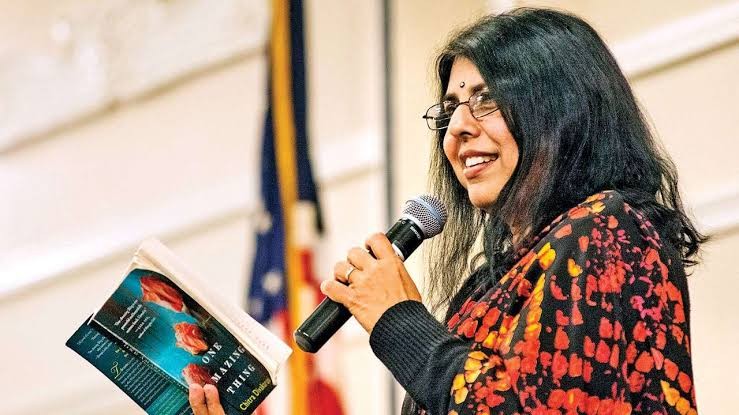
Ram’s life and times, from the perspective of his wife, Sita

In The Forest of Enchantments, Chitra Banerjee Divakaruni steers clear of a male-centric retelling of Rishi Valmiki’s Ramayana by narrating the story of Ram, king of Ayodhya, from his wife Sita’s perspective. Through this device, Divakaruni offers a critical reassessment of the Sanskrit epic that, in turn, situates the concerns of women at the fulcrum of a familiar story. What follows is a harrowing account that mixes a mosaic of facts with an intensely moving story of a woman who endured countless predicaments for her husband and his kingdom.
The novel begins in Valmiki’s hermitage where the banished Sita - who self-deprecatingly refers to herself as "a queen bereft of her kingdom" - lives with her twin sons, Kush and Lav. Valmiki hands her a tome that embodies his "life’s work": an epic poem on King Ram’s glorious reign. He asks her to read it before he can teach her sons to sing it. After a careful perusal of the text, Sita realises that Valmiki has failed to chronicle her experiences, sacrifices and pathos.
When Sita voices her misgivings about the poem to Valmiki, the sage encourages her to write her own story. Armed with a sealed bottle of ink, a sheaf of pounded leaves and a set of quills, she begins writing the "Sitayan".
Divakaruni’s decision to present a first-person narrative serves the dual benefit of highlighting her intimate struggle and exploring the intention of the other women who feature in the Ramayana. The author is painfully aware of the fact that most of these women have been pushed to the fringes and viciously maligned throughout history. As a result, she has made every attempt to depict them in an impartial and authentic manner.
Conventional wisdom would have us believe that first-person narratives prevent writers from sensitively portraying complex characters. However, Sita’s voice is honed to a purpose and modulated with care to offer an objective glimpse of events. At no point does the author allow her protagonist to become an unreliable narrator. There is no rancour in Sita’s retelling of those fragments of her life that have left her in a vulnerable position. She remains level-headed in her interpretation of people and their intentions, and doesn’t censure them on the basis of a personal grudge. That explains why Kaikeyi, her stepmother-in-law who is responsible for banishing Ram and Sita to the forest, is portrayed with rare compassion and a humane touch.
By the same token, The Forest of Enchantments doesn’t reduce Sita to a paragon. In her author’s note, Divakaruni categorically states that "Sita may be the incarnation of the goddess Lakshmi but, having taken on a mortal body, she is human, too, with human failings". Instead, her decisions are fuelled by a "quiet courage" that helps her brave obstacles without compromising on her dignity.
As she weaves together the tragic love story of Ram and Sita, the author remains mindful of Sita’s foibles as well as her strengths. They confront unprecedented circumstances in the forest, including Sita’s notorious abduction by Ravan, which leave permanent scars on their relationship. And yet, no one is blamed for the consequences or subjected to harsh scrutiny. Even Ravan isn’t relegated to the status of a cold-blooded antagonist and is permitted an opportunity to present the gentler aspects of his demeanour to readers. Devoid of harsh judgements and convenient stereotypes, the novel provides a recurring meditation on the nature of love that, Sita believes, is aligned closely with compassion.
With lyrical prose and a storyteller’s eye for detail, Divakaruni explores Sita’s choices and her unending association with misfortune. At times, the richly layered style of the novel is compromised by a slight proclivity for melodrama. There are occasional references to the "dark hopelessness of [Sita’s] heart" that seem to create this effect. But these minor lapses do little to weaken the overall essence of the novel. Divakaruni’s Sitayan is yet another testament of her ability to explore the plight, peril and pleasures in the lives of Indian women.
The Forest of Enchantments is fundamentally different from Valmiki’s Ramayana because it doesn’t lionise Ram by fixating on his "adventures as hero and king". The emphasis remains on a different form of heroic struggle that places women at its centre, and goes beyond battlefields and tales of valour. Sita’s search for dignity and her unwillingness to accept injustice are the ingredients that give her moral courage and strength of character.
Written with an unmistakable precision, The Forest of Enchantments evokes an image of Sita that is devoid of meekness and filled with benevolence. Readers who enjoy exploring the many facets of historical events will find Divakaruni’s latest novel to be a quick, insightful read.
The Forest of Enchantments
Author: Chitra Banerjee Divakaruni
Publisher: HarperCollins India
Pages: 358
Price: US$11.24